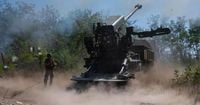In a dramatic escalation of hostilities, both Ukraine and Russia have launched high-profile attacks and counterattacks across the Black Sea and western Ukraine, underscoring the war’s relentless evolution even as diplomats on both sides continue to talk—sometimes at cross purposes—about a possible path to peace.
On August 22, 2025, the Ukrainian Navy struck a Russian drone base at the Khersones airfield in occupied Sevastopol, Crimea, according to a statement released by Ukraine’s naval command and reported by The Kyiv Independent. The daring attack reportedly destroyed three Iranian-made Mohajer-6 drones and two Russian Forpost drones. These unmanned aircraft, used extensively by Russian forces to monitor activity in the Black Sea and target Ukrainian missile systems, have played a pivotal role in Russia’s surveillance and strike capabilities since the annexation of Crimea in 2014. The Ukrainian Navy emphasized that the Mohajer-6 drones, with their impressive 200-kilometer range, have been instrumental in Russia’s efforts to control the strategic waterway.
While the precise weapon used in the attack and the exact timing remain unclear, the Ukrainian military has ramped up its campaign against Russian military infrastructure on the peninsula since the full-scale invasion began in 2022. Earlier in August, Ukrainian forces also claimed a strike on the Yenisei radar station, a critical component of Russia’s advanced S-500 air defense system in Crimea—a move that further signaled Kyiv’s intent to contest Russian dominance in the region.
That same day, Ukraine’s defense intelligence agency (HUR) announced the destruction of a Russian patrol boat in the Black Sea near Zaliznyi Port, Kherson Oblast. The operation, which employed a laser-guided missile illuminated by a drone, resulted in the complete loss of the Russian vessel and its crew. In a statement quoted by multiple outlets, the HUR declared, “The high-precision destructive strike with a missile on an enemy target in the Black Sea was made possible thanks to laser illumination from a drone, which also recorded the successful destruction of the military boat with the Russians.” The agency stressed that this strike was further evidence that “the armed struggle for Ukraine continues,” despite what it characterized as Russian President Vladimir Putin’s rhetorical overtures for peace.
Yet, even as Ukraine demonstrates its capacity for precision strikes, the broader picture on the ground remains sobering. Western-supplied tanks—once heralded as game-changers—have not tipped the balance. According to a detailed analysis by Isaac Seitz in the National Security Journal, the much-anticipated deployment of M1 Abrams, Leopard 2, and Challenger 2 tanks has failed to shift the war’s momentum in Ukraine’s favor. These state-of-the-art machines have suffered significant losses, primarily to Russian first-person-view (FPV) drones, anti-tank guided missiles like the Kornet, and dense minefields stretching across the front lines.
The Leopard 2, supplied by a broad European coalition, debuted in the 2023 Zaporizhzhia counteroffensive but struggled to overcome Russian minefields and attack helicopters. While the tank’s survivability allowed crews to escape after hits, its large profile made it an easy target in the drone-dominated battlespace. The M1 Abrams, delivered by the United States and promised in greater numbers by Australia, saw its first combat in early 2024 during the defense of Avdeevka. However, the tanks quickly fell victim to Russian drone swarms and anti-tank missiles, with only four of the original thirty-one vehicles remaining by June 2025.
British Challenger 2 tanks, long touted for their reliability and firepower, also met with disappointment. After an initial period relegated to propaganda appearances, they returned to combat in 2024’s ill-fated Kursk offensive. At least five have been confirmed destroyed, with more damaged. Seitz’s analysis points to a combination of factors: Western tanks were not designed for today’s drone-centric warfare, their large silhouettes made them easy prey, and Ukrainian and Western planners underestimated the sophistication and determination of Russian anti-tank defenses. “Quality alone does not decide wars,” Seitz writes, noting that fewer than 400 Western tanks could not compensate for poor intelligence and planning. The lesson, he argues, is that future offensives will require far better operational preparation and a clear-eyed assessment of Russian capabilities.
Meanwhile, Russia has not been idle. On the night of August 21-22, Moscow launched one of its largest drone and missile barrages of the year against western Ukraine—an area that had largely escaped such focused attacks. According to reports from 1News and the Associated Press, the assault targeted, among other sites, an American-owned electronics plant near the Hungarian border. The Flex factory, one of the largest US investments in Ukraine, was struck while 600 night shift workers were present, injuring six. Andy Hunder, president of the American Chamber of Commerce in Ukraine, lamented the attack, saying, “The message is clear: Russia is not looking for peace. Russia is attacking American business in Ukraine, humiliating American business.”
The Russian Defense Ministry claimed the strikes were aimed at Ukrainian military-industrial enterprises, including drone factories and storage depots, and denied targeting civilian infrastructure. However, in the western city of Lviv, the attack killed one person and injured three, damaging residential buildings, a kindergarten, and administrative offices. Regional officials reported that Russian cruise missiles with cluster munitions were used, intensifying concerns about the humanitarian toll of the conflict.
These attacks unfolded against the backdrop of renewed diplomatic activity. US President Donald Trump, after meeting with Russian President Vladimir Putin in Alaska and subsequently hosting Ukrainian President Volodymyr Zelensky and European leaders in Washington, criticized his predecessor, Joe Biden, for not providing Ukraine with more decisive weaponry. “It is very hard, if not impossible, to win a war without attacking an invader’s country,” Trump posted on social media. “It’s like a great team in sports that has a fantastic defense, but is not allowed to play offensive. There is no chance of winning! It is like that with Ukraine and Russia.”
Diplomatic discussions continue, with US Secretary of State Marco Rubio convening a conference call with European national security advisers to discuss future security guarantees for Ukraine. Military leaders from Ukraine, the US, UK, Finland, France, Germany, and Italy also met in Washington to explore military options. While the Kremlin insists that meaningful security arrangements cannot proceed without Moscow’s involvement, Ukrainian and European leaders accuse President Putin of stalling, hoping to gain more territory before peace terms are finalized.
President Zelensky, for his part, has condemned the latest Russian attacks as evidence that Moscow is not serious about ending the war. He has called for stronger international pressure, including tougher sanctions and tariffs, and indicated that plans for security guarantees should be clearer by next week. Zelensky also expressed openness to direct talks with Putin—potentially in a trilateral format with Trump participating—though he acknowledged that significant issues remain unresolved and that a venue is still under discussion.
As the war grinds on, both sides continue to innovate and adapt, with Ukraine’s drone-guided strikes and Russia’s massive aerial barrages highlighting the evolving nature of modern warfare. The fate of Western-supplied tanks, the resilience of Ukrainian forces, and the shifting diplomatic landscape all point to a conflict that is far from settled, with each new day bringing both hope and uncertainty for those on the front lines and in negotiating rooms alike.

